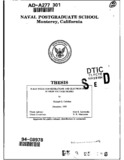X-ray pulse considerations and electron flow in high voltage vacuum diodes
| dc.contributor.advisor | Schwirzke, Fred R. | |
| dc.contributor.advisor | Maruyama, Xavier K. | |
| dc.contributor.author | Callahan, Michael O. | |
| dc.date | December 1993 | |
| dc.date.accessioned | 2014-03-26T23:22:42Z | |
| dc.date.available | 2014-03-26T23:22:42Z | |
| dc.date.issued | 1993-12 | |
| dc.identifier.uri | https://hdl.handle.net/10945/39666 | |
| dc.description.abstract | Electrical breakdown in high voltage diodes has been studied since the 1920s, yet it is still not well understood. This study characterizes the electron flow during breakdown in a high voltage vacuum diode. This was accomplished by measuring the x rays produced when electrons strike the anode of the diode. Current measurements taken during the experiment include both the displacement and conduction electron current, so the x-ray signal is the best measure of the conduction current. Knowledge of the electron flow is important in determining the mechanism of breakdown. The currently accepted explosive electron emission (EEE) model for electrical breakdown can not properly account for the energy required to form cathode spots. Schwirzke proposed a new model that involves an ionization process and a subsequent unipolar arc that accounts for the energy to form the spots. Electron flow for the two models is very different. The EEE model requires a large current density for several nanoseconds before plasma formation, whereas the new model predicts a large current density that develops simultaneously with the plasma formation. The results of thus experiment support the predictions of the new model. | en_US |
| dc.description.uri | http://archive.org/details/xraypulseconside1094539666 | |
| dc.format.extent | 69 p. | en_US |
| dc.language.iso | en_US | |
| dc.publisher | Monterey, California. Naval Postgraduate School | en_US |
| dc.rights | This publication is a work of the U.S. Government as defined in Title 17, United States Code, Section 101. Copyright protection is not available for this work in the United States. | en_US |
| dc.title | X-ray pulse considerations and electron flow in high voltage vacuum diodes | en_US |
| dc.type | Thesis | en_US |
| dc.contributor.corporate | Naval Postgraduate School (U.S.) | |
| dc.contributor.department | Physics | |
| dc.subject.author | Current density | en_US |
| dc.subject.author | Cathode spot | en_US |
| dc.subject.author | Vacuum diode | en_US |
| dc.subject.author | Unipolar arc | en_US |
| dc.subject.author | Space charge | en_US |
| dc.subject.author | X-ray | en_US |
| dc.description.service | Captain, United States Army | en_US |
| etd.thesisdegree.name | M.S. in Physics | en_US |
| etd.thesisdegree.level | Masters | en_US |
| etd.thesisdegree.discipline | Physics | en_US |
| etd.thesisdegree.grantor | Naval Postgraduate School | en_US |
| dc.description.distributionstatement | Approved for public release; distribution is unlimited. |
Files in this item
This item appears in the following Collection(s)
-
1. Thesis and Dissertation Collection, all items
Publicly releasable NPS Theses, Dissertations, MBA Professional Reports, Joint Applied Projects, Systems Engineering Project Reports and other NPS degree-earning written works.





